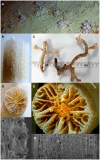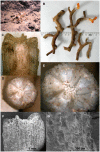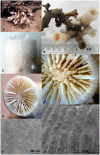First biological measurements of deep-sea corals from the Red Sea
- PMID: 24091830
- PMCID: PMC3789407
- DOI: 10.1038/srep02802
First biological measurements of deep-sea corals from the Red Sea
Abstract
It is usually assumed that metabolic constraints restrict deep-sea corals to cold-water habitats, with 'deep-sea' and 'cold-water' corals often used as synonymous. Here we report on the first measurements of biological characters of deep-sea corals from the central Red Sea, where they occur at temperatures exceeding 20°C in highly oligotrophic and oxygen-limited waters. Low respiration rates, low calcification rates, and minimized tissue cover indicate that a reduced metabolism is one of the key adaptations to prevailing environmental conditions. We investigated four sites and encountered six species of which at least two appear to be undescribed. One species is previously reported from the Red Sea but occurs in deep cold waters outside the Red Sea raising interesting questions about presumed environmental constraints for other deep-sea corals. Our findings suggest that the present understanding of deep-sea coral persistence and resilience needs to be revisited.
Figures






References
-
- Cairns S. Species richness of recent scleractinia. Atoll Res. Bull. 459, 1–12 (1999).
-
- Roberts J. M., Wheeler A. J. & Freiwald A. Reefs of the deep: the biology and geology of cold-water coral ecosystems. Science 312, 543–547 (2006). - PubMed
-
- Davies A. et al. Downwelling and deep-water bottom currents as food supply mechanisms to the cold-water coral Lophelia pertusa (Scleractinia) at the Mingulay Reef complex. Limnol. Oceanogr. 54, 620–629 (2009).
-
- Rogers A. D. The biology of seamounts. Adv. Mar. Biol. 30, 305–350 (1994). - PubMed
MeSH terms
Substances
Associated data
- Actions
- Actions
- Actions
LinkOut - more resources
Full Text Sources
Other Literature Sources

